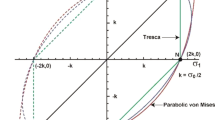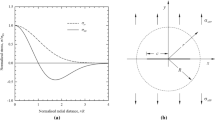Abstract
A theory of stable crack growth, for generalized plane stress conditions, is presented which is based upon a Dugdale model of plasticity and an energy balance approach to fracture. Several forms for the rate of energy dissipation in the plastic zone are considered. It is shown that the J-integral, when used in conjunction with the Dugdale model, may not be of direct relevance to the rate of stable crack growth. By introducing the well known concept of a fracture process zone, and incorporating it into an expression for the rate of energy dissipation in the plastic zone, a simple stable crack growth law is derived which is very similar to an existing relation based upon a “final stretch” fracture criterion.
The energy balance approach is extended to derive the growth law for cracks propagating in test specimens subjected to point loads. The material may be non-linear elastic-plastic provided that the Dugdale model of yield is appropriate. It is shown how load-displacement records might be used to predict the amount of stable crack growth in linear elastic-perfectly plastic sheets having reasonably general geometries which are subjected to point loads.
Résumé
On présente une théorie pour la croissance stable d'une fissure dans le cas de conditions d'état plan de déformation généralisé, qui est basée sur le modèle de Dugdale de plasticité et sur une approche d'équilibre d'énergie jusqu'á la rupture. Diverses formes sont envisagées pour le taux de dissipation d'énergie dans la zône plastique. On montre que l'intégrale J, lorsqu' elle est utilisée en conjonction avec le modèle de Dugdale, peut n'être pas directement pertinente pour déterminer la vitesse de croissance stable d'une fissure. En introduisant le concept bien connu de la zône du processus de fracture et en l'incorporant dans l'expression donnant la vitesse de dispersion d'énergie dans la zône plastique, on dérive une loi de croissance stable et simple de la fissure qui est très similaire à la relation existante basée sur un critère de rupture par “étirement final”.
L'approche de l'équilibre d'énergie est étendue afin de dériver la loi de croissance de fissure se propageant dans des éprouvettes d'essai soumises à des charges ponctuelles. Le matériau peut être non linéaire élastique-plastique pourvu que le modèle de Dugdale de l'écoulement plastique soit approprié. On montre comment les enregistrements charge-déplacement peuvent être utilisés pour prédire le taux de croissance stable d'une fissure dans des tôles minces à caractéristiques linéaires élastiques et parfaitement plastiques, et possédant une géométrie raisonnablement générale, et soumises à des charges ponctuelles.
Similar content being viewed by others
References
G.P. Cherepanov, Prikladraya Mat. Mechanika, 32 (1968) 1050 (English version).
G.P. Cherepanov, International Journal of Solids and Structures, 41 (1968) 811.
M.P. Wnuk, International Journal of Fracture Mechanics, 7 (1991) 383.
D.S. Dugdale, Journal of Mechanics and Physics of Solids, 8 (1960) 100.
J.R. Rice, Fracture (ed. H. Liebowitz) Vol. 2, Academic Press, New York (1968).
J.R. Rice, Applied Mechanics Reviews, Review No. 6185, 23 (1970) 917.
M.P. Wnuk, Trans. ASME, Journal of Applied Mechanics, 41 (1974) 234.
K.H. Swinden, Ph.D. Thesis, University of Sheffield (1964).
J.R. Rice, Proc. 1st International Congress on Fracture (ed. Yokobori et al.) Sendai, Japan, Vol. 1 (1966) 309.
T. Yokobori and M. Ichikawa, Rep. Res. Inst. for Strength and Fracture of Materials, Tohoku University, Sendai, Japan, 2 (1966) 21.
B.A. Bilby and J.D. Eshelby, Fracture (ed. H. Liebowitz) Vol. 1, Academic Press, New York (1968) 99.
J.A. Begley and J.D. Landes, ASTM STP, 514 (1971) 1–39.
Author information
Authors and Affiliations
Rights and permissions
About this article
Cite this article
McCartney, L.N. Theory of stable crack growth in an elastic-perfectly plastic material. Int J Fract 14, 429–438 (1978). https://doi.org/10.1007/BF00015994
Received:
Issue Date:
DOI: https://doi.org/10.1007/BF00015994




